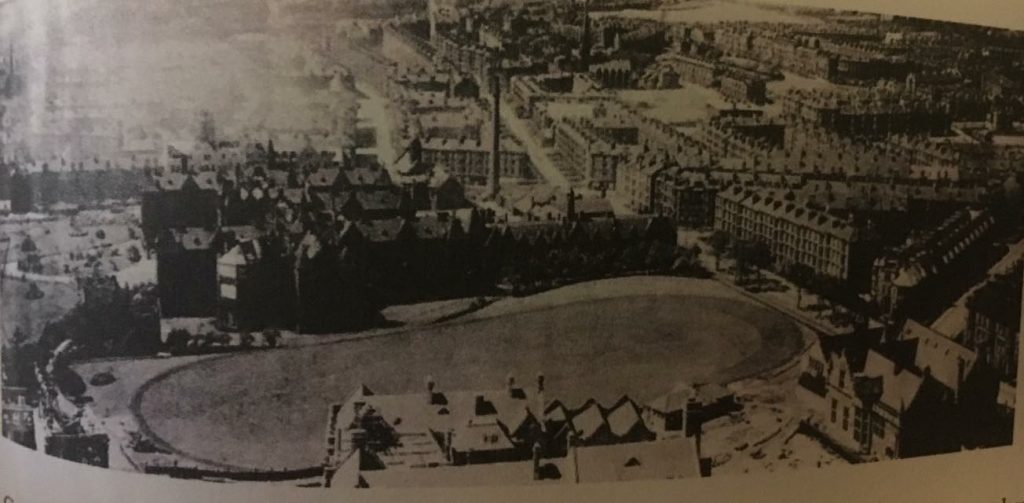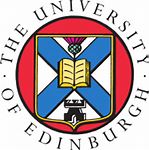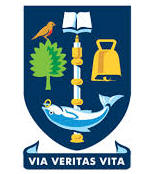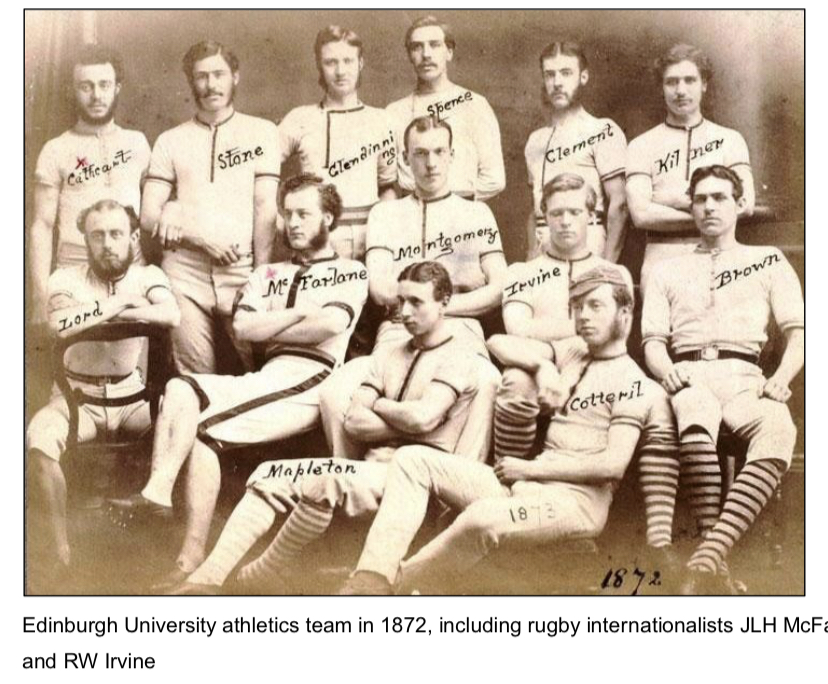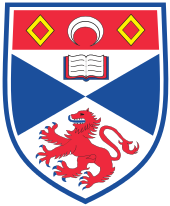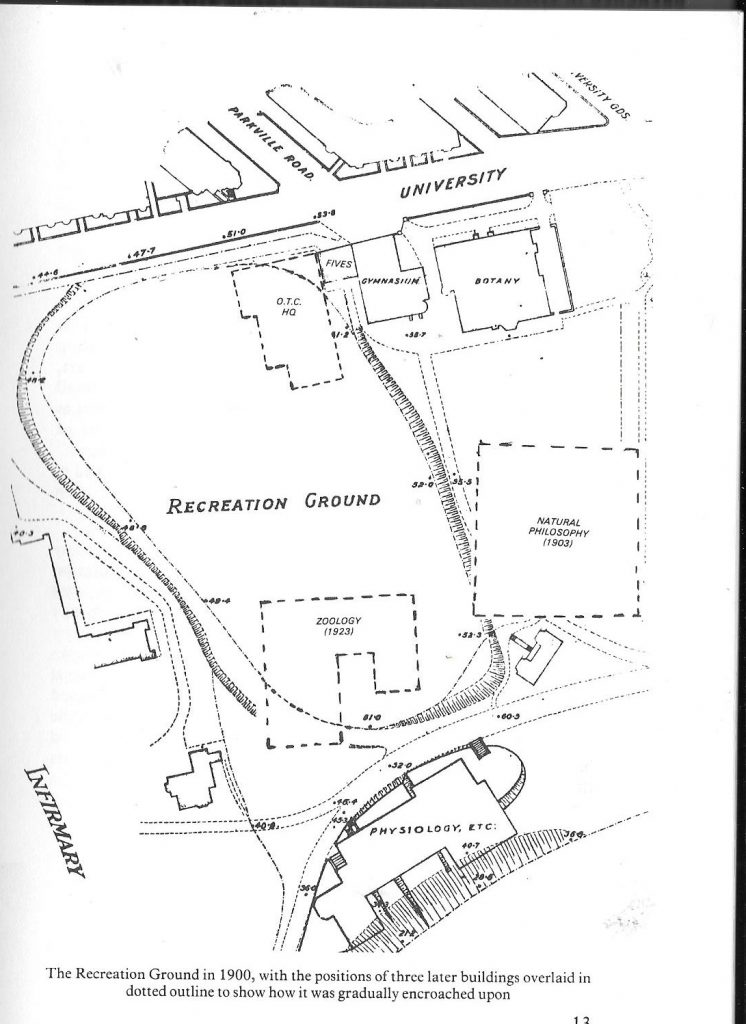The Glasgow University grounds at Gilmorehill
The Inter-University Sports began in March, 1871. The Scotsman of 25th March which tells us that the event took place on Saturday, 18th March, 1871. The report in the Scotsman of two days later, read as follows (under the heading of ‘Gymnastics’).
The first annual Scottish Inter-University Sports came off on Saturday with gratifying success at the Academical Club’s grounds at Raeburn Place. An Inter-University gathering for Scotland similar to that which is annually held for the students of Oxford and Cambridge was attempted to be got up last year but owing to some misunderstanding on the part of the Aberdeen students committee, the arrangements fell through. Early in the present year, overtures were made by representatives from Edinburgh, Glasgow and St Andrews for a trial of athletic supremacy, and the result of the negotiations was the highly satisfactory celebration of sport on Saturday, which, it may now be anticipated, will be an annual affair. The weather, tat most important element in the success of outdoor sports, was fair and mild, and the cricket ground was visited by several thousand ladies and gentlemen. The scene was gay and animated and the pleasure of the visitors was enhanced by the performance of the band of the 13th Hussars. The programme was similar to that carried out at the anniversary of the great English Universities – the chief items being a 100 yards, quarter mile, mile and two miles races, jumping, putting the cannon-ball and throwing the hammer. The members of each university were easily distinguished by the coloured badges. The arrangements were however, but indifferent and the sports were protracted beyond measure. Edinburgh University at the close showed well in front – the lion’s share of the prizes falling to the students of the metropolitan college.”
“The first event was throwing the cricket ball, and Le Mesurier, Edinburgh, distanced his opponents – winning the prize with a throw of 100 yards 2 inches. Then came the sprint race. In the first heat, Rayner (E) took the lead of Guerard (St A) and Sands (St A) and retaining it to the tape, won by a yard. Cathcart jumped off from score with an advantage in the second heat, and secured victory after a capital struggle from Hill (St A) and McCausland (G) by a yard and a half. Butler (St A) walked over for the third heat – his two opponents not putting in an appearance. In the final, Rayner, who started next to the ropes, pressed his two opponents to the left in a manner which would have been decided a foul in any running track, came in first a foot in front of Cathcart, but so far had all three run out of their lines that they were without the tape, and the judges ordered the race to be run over again as neither of the competitors had breasted the tape! On another attempt Rayner and Cathcart ran a dead heat and the judges awarded a medal to each. The Mile race, for which there were nine competitors excited considerable interest. Mapleton, the winner at the trial sports, was favourite. At the pistol shot, Towers Clark (G) made the running at a tremendous pace the third of a mile and led by 30 yards, when Hunter (St A) went up to the front and held a lead of 10 yards, Mapleton and Kinloch being in the ruck. The two last named shot out and joined Hunter in running up the back stretch. In the last lap, Mapleton, Kinloch and Hunter ran a tremendous race to the south path where Kinloch gave Hunter the go-by – Mapleton who had been too late in putting the steam on and had therefore a deal of ground to make up, struggling after them. Entering the straight, Kinloch had a lead of five yards and he won by three and a half yards. A splendid struggle for second honours went on between Hunter and Mapleton – the latter being beaten by only 18 inches. Hitherto all the honours had gone to Edinburgh but in putting the weight, St Andrews got a turn, the victor being Lundie who putted the cannon ball 41 feet. For the quarter Mile there was a very good struggle although the event was never really in doubt for Rayner who led all the way and won by 20 yards. Macfarlane (E) won the wide jump very easily – neither of his opponents reaching his first jump. The hurdle race was an exciting event. Marshall walked over for the first heat, and in the second Macfarlane got beat contrary to expectations by Bairnsfather (St A) by a foot. R McFarlane (G) fell. We believe Macfarlane was put back a foot for a false start. Spence (E) fell in the third heat and Greathead won. The final after a great race proved a dead heat between Marshall and Bairnsfather. The two mile race was another turnup – Hunter (St A) being looked upon as the best at that distance. Fisher (St A) , AI McCrae and Richardson (in the order named) ran the first lap when Richardson went to the front. Hunter last of all. All of them dropped out by the fifth round except Richardson, McCrae and Hunter and the former won by 40 yards, Hunter 6 yards behind McCrae.
It may be mentioned that the winner of the mile, Kinloch, has secured good honours at Cambridge on the ash and ran for Hutchinson, who won the right to contest the Mile in the trial sports a fortnight ago. He thought before the race that his chance was so hopeless that we believe he offered to make the pace for the favourite Mapleton. Rayner, the winner of the quarter mile and of the victors in the 100 yards, is the best amateur that the University has produced since Dr C Bauchope’s day. Hunter and Guerard who made such a good appearance for St Andrews in the mile and quarter mile respectively, would have given a much better account of themselves had they run in spiked shoes and got such a training as the Edinburgh men received. Mr T Callaghan, manager of Powderhall grounds, acted as starter with the pistol. The judges were Professor Cowan, Glasgow, and Professor Heddle, St Andrews.”
It was a good detailed report which has been reprinted in its entirety (apart from the list of results which can be consulted at the newspaper) for two reasons. First it was the ‘first annual’ meeting and should be available; and second, for what the detail of the report tells us about the sport of the day and the roots of modern athletics.
The very successful Edinburgh team had clearly taken the event very seriously and had held a full on trial on 4th March in the Merchiston School grounds where “Those capable of judging considered the performances no proper criterion of the merits of the competitors, who were placed at a great disadvantage in contending on so unsuitable ground and it really is a pity that this, the most important club in Scotland, does not celebrate their sports on a proper enclosed ground.” The lamentations continued, but the events produced most of those who won the competition twp weeks later: Le Mesurier won the cricket ball, Mapleton the Mile, McFarlane the Long Leap (called the wide jump in the inter universities), Cathcart and Urquhart equal in the 100 yards, Urquhart the quarter mile, McFarlane the hurdle race, Mapleton and Richardson were 1-2 in the two miles, and Sievewright the high leap.
The Glasgow Herald report of the same date was quite critical of the home team. Note the following extract.
“Edinburgh carried off eight prizes, St Andrews three; but unfortunately Glasgow did not secure one. The Glasgow competitors showed a great want of training, but, no doubt, their ill-luck on this occasion will incite them to great efforts so that they may be better prepared for the Sports of 1872. The prizes, which consisted of handsome medals, were presented to the successful men by the judges.”
University of Glasgow
A pre-script, as opposed to a post-script, of the championships appeared in the form of this item in the ‘Scotsman’ of 18th March, 1872.
“ATHLETICS
Glasgow University Trial Sports. These preliminary trials in connection with the Inter-University Sports, came off on the University field at Gilmorehill on Saturday, but they were considered private, and therefore do not call for particular comment.”
They must have had an inch of space on the page that day, but the message was clear: Glasgow University was taking this year’s championships more seriously than last year’s. It was after all a home fixture, and they had been roundly criticised for their performance.
The sports were held the following Saturday and the report read:
“The Scottish Inter-University Sports took place on Saturday at Burnbank Cricket Ground, Glasgow. With the rising popularity of athletics in schools and colleges, an annual competition between the members of the Scottish Universities , similar to that yearly held between the two great Universities of England, was desiderated, both on account of the good fellowship and feelings such meetings would promote between the students of the four national Universities, and the spirit of friendly emulation which they would excite. Accordingly three years ago an effort was made to arrange an inter-University gala at Perth, but owing to some misunderstanding with the Aberdeen representatives, the meeting did not take place. Aberdeen still held back last year, but Edinburgh, Glasgow and St Andrews went heartily into the proposal and a highly satisfactory meeting took place in Edinburgh in March last. This year the Aberdonians joined issue with the Southern Universities and the meeting on Saturday was thoroughly representative and national. The cricket ground at Burnbank is scarcely a suitable place for an athletics gathering , the turf being indifferent and the “going” bad. This drawback to the entire success of the sports was increased by the inauspicious nature of the weather Snow hail and sleet fell at short intervals throughout the day, and a piercingly cold wind prevailed. The spectators, as might be supposed, were few in number and although the band of the 90th Regiment did all that they could by their excellent performances to enliven the proceedings, enthusiasm did not run high nor was the assemblage ever particularly gay. Last year Edinburgh came in for the lion’s share of the honours and the Glasgow men were unable to gain even one prize; but the students in St Mungo seem to have made good use of the gymnasium at the new University at Gilmorehill, which, by the way, is said to be the best appointed north of Liverpool, as they carried off on Saturday a fair share of the awards.
The sports commenced with throwing the cricket ball and JM Cotterill. Edinburgh, secured the medal for a throw of 110 ½ yards, Le Mesurier being second with a throw of 108 yards 10 inches. The last named gentleman was first last year with a throw of 100 yards 2 inches, so that the work of Saturday showed a considerable improvement. The sprint race was run in two Heats – the first of which was won by Johnston, Glasgow, who made all the running and won by a yard from Williamson, Aberdeen, and Calverly, Edinburgh, who ran for Macfarlane who wished to reserve himself for the quarter mile. In the second Heat, J Neill, Edinburgh, won rather easily from R Thomson, Glasgow; but in the final Thomson reversed positions and beat Neill. Thomson got a yard the best of the start and he and Neill soon drew out from the other pair. Neill at half distance soon drew alongside Thomson and seemed to have the race in hand, but the latter stuck to his work like a game-cock, would not be shaken off, and making a good spurt at the finish, landed the best event of the day by six inches. After the first round of putting the ball it was easily observable that only Lundie, St Andrews, and Forsyth, Edinburgh, were in it, and the former eventually won easily, the distance being 32 feet 6 ½ inches to Forsyth’s 32 feet 1 inch, although Lundie could easily have thrown another 9 feet: last year he won the medal by a throw of 41 feet. The quarter mile was a somewhat hollow affair as Macfarlane, Edinburgh, had the race in hand from end to end. The wide jump was secured by D McKinnon, Glasgow, the distance covered being 17 feet 2 ½ inches. This performance of the Edinburgh representative was disappointing, and he must have been out of practice as at the Inter-Universities Sports last year he carried off the medal with a jump of 19 feet 9 inches and he has more than once cleared 21 feet. The Mile was another rather indifferent event and possessed none of the interest as that of last year. Mapleton who broke down in this event in 1871 when favourite and only finished third, drew out from the start, attended by Dick, St Andrews, and Richardson, Edinburgh. The latter gentleman had evidently not been in training, and he cut it, and the favourite came in as winner, Dick second, Richardson third. Brown Edinburgh, and Brownlow, Glasgow, tied for the high jump at 5 feet ½ inch, but the rising ground was bad or the result might have been different, as the former secured the medal in 1871 with a jump 7 inches higher. Macfarlane won the hurdles race with great ease. Lundie and Forsyth out distanced their opponents at throwing the hammer at the outset, but Lundie had not such an easy victory over the Edinburgh representative as in putting the ball, for after an exciting contest he only beat Forsyth by 11 inches – the distance being – Lundie 73 feet 11 inches, Forsyth 73 feet. The Mile Walk created some fun and Councell, Aberdeen, – a very smart walker – would have won but, thinking he had completed the Mile, he stopped short a lap and Forsyth won. The judges were Professor MacLeod and Mr JJ Reid, Glasgow, and the start was Captain Glascott, 32nd Regiment.”
University of St Andrews
On 15th April, 1873 it was the turn of St Andrews to host the championship and ‘the sports took place in a field close to the town, and being of a sandy soil. was well adapted for the purpose.‘ The difference this time round was that the University of Aberdeen took part in the event. Well, one athlete represented the northernmost university but we can come back to that. There were eleven events and the result was another victory for Edinburgh. They had six first and five second prizes, St Andrews had two firsts and two seconds, Glasgow had two firsts and two seconds and Aberdeen had one first and one second. There was the repeated assertion that the meeting was not well run: “No one seemed to know how to manage a meeting of this kind except perhaps Professor Heddle, who acted as Judge and worked most zealously to keep things moving.”
There was however a genuine organisational matter which arose early in the afternoon: “Aberdeen was only represented by Mr G Cran, her most favourable entrant, J McCombie Smith, although attending the College daily, having been objected to on the ground that he had at one time or another taken part in public or professional meetings. Rather a hard law, certainly, and one that will doubtless cause a deal of discussion in athletic circles.”
Many of the winners were recognisable from the previous meetings: Cotterill (E) won the cricket ball, Thomson (G) the 100 yards, Dick (St A) won the half mile, Cran (A) the High Leap, Montgomery (E) won putting the 22lb stone and the hammer, Cathcart (E) the quarter mile, Brunton (G) the Long Jump, McFarlane (E) the hurdles, Mile Lord (E) and vaulting with the pole was a tie between TC Hope (G) and P Anton (St A). There was one strangely named new event. It was the “Hop, Step (or Two Hops) and Jump” and was won by HL Dick of St Andrews.
The Glasgow University facility at Gilmorehill
On the Tuesday after the Sports, the following letter appeared in The Scotsman.
Scottish Inter University sports
Aberdeen, March 17th, 1873
Sir – In connection with the so-called “Scottish Inter-University Sports” at St Andrews on Saturday last, I hope you will allow me to make a few remarks as to the justness of the acting committee’s decision in debarring me from competing.
Until Saturday last these sports were believed by most students, and by the public at large in Scotland, to be open to all regularly matriculated students of the Scottish Universities. Being a regularly matriculated student of Aberdeen University, I was therefore considerably surprised when a member of the Edinburgh University Athletic Club told me that if I had ever run with a professional I could not be allowed to compete. Now if this decision had come b y a majority of the students attending the Scottish Universities, I would have let the matter rest, but having good reason to that I was disqualified by a number of interested individuals, intrusted with power to disqualify whom they pleased, I protest against their decision, and I hope that in future these sports will be open to all regularly matriculated students of the Scottish Universities, and that next year, when the Edinburgh men come to Aberdeen, they will not have it in their power to disqualify anyone whom they are afraid to meet in straightforward, honourable trial.
In conclusion, lest the Edinburgh University athletes should be too elated with their victories of Saturday last, I have great pleasure in acquainting them with the following facts:- 1st, that I am a regularly matriculated student of a Scottish University; 2d That I am prepared to prove my ability to win 6 out of the 11 events forming the programme of the “Scottish Inter-University Sports” from any student of the four Scottish Universities, and am therefore, the Champion University Athlete of Scotland.
William McCombie Smith.
On the Wednesday came the reply:
Edinburgh, March 19th, 1873
Sir –
In reply to Mr McCombie Smith’s letter in today’s Scotsman, as the member of the Edinburgh University Athletic Club alluded to by him, and as Hon. Sec. of the EUAC, I hope you will allow me to place the true state of the case before the Public. Although the Scottish Inter-University Sports are open to members of the four Scottish Universities, they are only open to such members as are amateurs, and anyone acquainted with Athletic matters will know that if Amateur should compete in any race open to Professionals he is thereby liable to be disqualified from competing in any future Amateur competition. Now on the ground on Saturday I asked Mr McCombie Smith not merely if he had competed with Professionals, but if he had competed in any races open to Professionals, and I distinctly understood him to say that he had done so. I did this, not on my responsibility, but as one of the Inter-University Committee appointed at Perth at the preliminary meeting in February, “with full power to disqualify if necessary.” Notice of this meeting was sent to members of Aberdeen University, but they did not think it necessary to send any representatives, so they had no representative on the Inter-University Committee.
None of the Inter-University Committee had any interested motive, as Mr McCombie Smith seems to think, but merely fulfilled the function they were appointed for; and it was not only the members of Edinburgh University, but those of Glasgow and St Andrews who objected to Mr McCombie Smithy taking part in the sports on Saturday.
Mr McCombie Smith was informed by the Secretary of St Andrews University Athletic Club two or three days previous to the Sports, that if he had ever competed in professional races, he would not be allowed to compete. Of course, any University might matriculate a professional, and thus have a “regularly matriculated student” to compete for them.
It is not probable that any athlete of any of the four Scottish Universities will condescend to dispute Mr McCombie Smith’s ‘modest’ assertion and claim contained in the last paragraph of his letter; but if he can satisfactorily prove that he has not competed in any open professional races, he will have an opportunity next year of “proving his ability” as an amateur athlete “in a straightforward, honourable trial” at the Scottish Inter-University Sports.
I am, yours, etc,
Charles W Cathcart, Hon. Sec., EUAC
At this point it would be interesting to see the appropriate Club and Committee Minutes to see where the dispute went. However, whatever the subsequent comings and goings, this was to be the last Inter-University Sports until 1899 when they would be revived with a match at King’s College Aberdeen.
Incidentally, as a footnote, there were several books published in the 1890’s by a William McCombie Smith (“The Romance of Poaching in the Highlands” was one). Given the timescale (eg the book mentioned was dated 1893) It could have been the same chap.) Since writing the above, Jack Davidson told us that McCombie Smith was Donald Dinnie’s brother-in-law and wrote a book on the highland games. He was indeed a good all-rounder who became a headmaster.
Inter Varsity Sports: the Missing Years Inter-Varsity Sports: 1899 – 1904 Inter-Varsity Sports: 1905 – 1909
